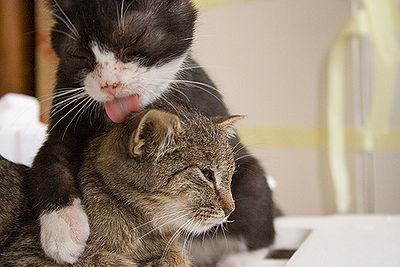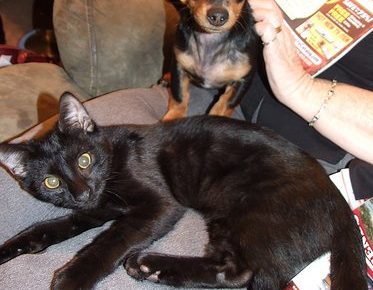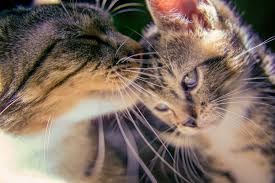
Ten Tips for Nine Lives
by Arnold Plotnick MS, DVM, ACVIM, ABVP
“I have another litter that needs placement”.
I’ve heard this sentence many times in the past few years. The speaker of the sentence is Theresa Bachu, a local animal rescuer with a mission: to spay and neuter as many feral cats in the New York City area as possible, and to find good homes for kittens born to those who’ve escaped her spay dragnet.
In 2003, I began collaborating with Theresa to help her achieve her lofty goals. By placing her kittens in my veterinary hospital display window (taking advantage of the brisk neighborhood foot-traffic), we’ve managed to place over 200 kittens into responsible, loving homes.
There are few things in life more endearing and enjoyable than a fuzzy new kitten. But caring for a kitten is a great responsibility, a commitment that often lasts 15 or even 20 years. To ensure that these kittens complete their kittenhood with flying colors, we educate our clients as to the many health, behavioral and well-being issues that need to be considered.
(1) Scan for Viruses
The Feline Leukemia Virus (FeLV) is one of the most feared, and most frustrating, virus of cats. Transmitted horizontally (from cat to cat) and vertically (from mother to offspring), this virus is essentially a death sentence for kittens that contract it. The American Association of Feline Practitioners (AAFP), in conjunction with the Academy of Feline Medicine (AFM), recommends testing all kittens for this virus. A positive test should be repeated and confirmed. “While adult cats that contract the disease may live several months (or even years) with good supportive care, kittens that contract FeLV rarely live a few weeks after the diagnosis is made”, says Dr. Michael Stone, a board-certified internist at the Cummings School of Veterinary Medicine at Tufts University. The absolute first thing you should do when acquiring a new kitten is to have it tested for the feline leukemia virus. “If there are other cats in the household, testing should be done before introducing the new kitten to your home, owing to the contagious nature of the virus”, he adds.
The feline immunodeficiency virus (FIV) is the feline equivalent of HIV in humans. While not as deadly as the leukemia virus, FIV is still of great concern. Cats that test positive for this virus eventually become susceptible to a variety of infectious diseases as the virus slowly ravages the immune system. It should be noted that testing kittens less than 6 months of age for FIV may yield unreliable results. “A positive test result in a kitten less than 6 months of age should be viewed cautiously, and should be repeated after the kitten has reached six months of age”, warns Dr. Stone. The feline leukemia test, on the other hand, is valid at any age, and kittens should be tested for the leukemia virus as soon as possible, preferably by 8 weeks of age. Of course, at my hospital, we test all of Theresa’s kittens the moment they arrive at our hospital.
(2) Hit me with your best shot(s)
Once confirmed that your kitten is FeLV and FIV negative, the best way to insure that it remains healthy is to begin the kitten vaccination series. Feline vaccinations are categorized as either “core” or “non-core”. Core vaccinations are those that every cat should get. Non-core vaccinations are those that may or may not be necessary, depending on the cat’s individual lifestyle.
“All kittens should be vaccinated against feline herpesvirus and calici virus, the two primary viruses responsible for upper respiratory infections in cats”, says Dr. Stone. “Kittens should also be vaccinated against panleukopenia, a viral disease that causes severe and often fatal diarrhea.” All kittens should be vaccinated against rabies as well. Several other vaccines are available for cats, however, vaccination should not be considered to be a benign procedure, and you should consult with your veterinarian as to which other vaccines may be necessary for your individual cat based on its lifestyle. We start the pediatric vaccination series on all of Theresa’s kittens as part of our adoption program.
(3) You Are What You Eat
Kittens grow as fast as weeds, and they require a high quality kitten food to insure proper development. Kitten food is higher in protein and energy density than adult foods. Kittenhood lasts a full year, so kittens should be fed food specifically formulated for kittens for the first twelve months of its life. Young kittens find eating a soft diet to be easier. Dry food may be moistened with water to make it easier to consume. As kittens mature, a complete and balanced dry food may be fed in addition to the canned food. Kittens that are around eight weeks of age should be fed three or four times daily. This can be reduced to two or three times daily by 12 weeks of age.
Kittens eat well as long as the food is tasty. Kittens fed a variety of flavors tend to be less selective eaters as adults. Avoid generic or unknown brands of food, and stick with the tried and true commercial and premium brands. If there is a dog or two in your household menagerie, it is imperative that your kitten not consume any significant amount of dog food. Cats have a unique requirement for taurine, an amino acid found in insufficient quantity in dog food. Taurine deficiency can lead to blindness and severe heart disease. Do not give milk to kittens, as it is likely to give them diarrhea. Avoid table scraps, as these can unbalance your kitten’s balanced diet, and can turn him into a finicky cat later on in life. Kittens that are being fed a complete and balanced diet do not need supplementary vitamins and minerals.
(4) Be Firm: Deworm
Gastrointestinal parasites are a common finding in kittens, with roundworms, hookworms, and coccidia being the most frequent offenders.
Intestinal worms (roundworms, hookworms) can accumulate in the digestive tract and deprive a kitten of valuable nutrients at this vulnerable stage in its life. The classic symptoms include an unthrifty, “pot-bellied” appearance and diarrhea. Coccidia are protozoan parasites that are rarely found in adult cats, but are relatively common in kittens, especially those obtained from unsanitary, multi-cat environments such as poorly run shelters, catteries, and pet stores. Diarrhea flecked with bright red blood, in association with straining and increased frequency of defecation, are classic symptoms of coccidiosis.
The small size of kittens can make them susceptible to life-threatening dehydration as a result. Fortunately, most intestinal parasites are easily addressed. A fecal specimen should be evaluated by a veterinarian, and appropriate dewormers given until fecal analysis demonstrates resolution of the problem. Over-the-counter dewormers from pet supply stores or supermarkets are usually ineffective and are not recommended. The kittens that Theresa brings us are from the street, and not surprisingly, intestinal parasites are a common finding. We analyze fecal samples from each kitten, and deworm appropriately before adoption.
(5) Mite Makes Wrong
Ear mites are pesky, microscopic bugs that can live in a kitten’s ears, causing itching and relentless discomfort. Often manifesting as an accumulation of dry, brown, crusty material in the ear canals, ear mites can cause kittens to scratch their ears so vigorously as to cause bleeding. Severe infestations can cause rupture of the eardrum and inflammation of the middle ear, resulting in balance and coordination problems. Evaluation of a sample of debris from the ear under a microscope allows for an easy diagnosis. Ear mites have become simpler to treat, thanks to the recent development of new topical (on the skin) and otic (in the ear) medications. We make sure that all of Theresa’s kittens leave our hospital might-free.
Sidebar 1: More Tips for Kitten Care – Here Comes the Groom
Cats naturally maintain their coats themselves, starting as young as several weeks of age. Their barbed tongues are perfect for removing dead skin cells and loose hair, but even the most talented tongue is no match for a dense winter coat or very thick fur, and they sometimes need our help, especially longhaired breeds. In fact, grooming is necessary for nearly all cats, and is vital to keeping your kitten healthy. When you groom your kitten, you help it remove unwanted hair, as well as skin flakes. Grooming spreads natural skin oils and adds luster to the coat. It also gets your kitten used to being handled, which encourages bonding, and allows you to perform a quick health-check on your kitten.
Start by using a brush with fine, relatively stiff bristles, such as a wire brush. Kittens get used to brushing quickly, and soon learn to enjoy it. While grooming, take note of the eyes, gently wiping away any matter that has accumulated in the corners of the eyes. Check the ears for excessive wax buildup. Be very careful if using a cotton swab to clean the ears. Do not lose sight of the tip of the swab, as delving too deeply into the ear could result in damage to the deeper structures within the canal. Longhaired kittens should be groomed often, to prevent mats from forming. If mats do form, never attempt to cut them with a scissors, as the mats can extend close to the skin, making it very easy for the kitten’s skin to be lacerated by the scissors.
Sidebar 2: More Tips for Kitten Care – Thinking Inside the Box
Often, a kitten will already be litter box savvy when you first bring it into your home. If not, kittens should be introduced to their litter box by six weeks of age. Because cats are instinctively fastidious about where they eliminate, housebreaking is usually an effortless task. However, cats and kittens can, and sometimes do, deviate from their good litter box habits. Most cats that relieve themselves in places other than their litter box do so for a reason, and the sooner the cause is realized, the greater the chances of successfully retraining the cat. Consult your veterinarian initially, as a medical issue may be the inciting cause of the inappropriate elimination behavior. If the problem is deemed behavioral, your veterinarian can advise you as to how to get your cat back on track, or may refer you to a behaviorist for those particularly difficult cases.
(6) Are We Having Fungus?
Ringworm is the most common infectious skin disease of kittens. Despite its name, ringworm is not a caused by a worm. It is a skin fungus. The classical appearance of feline ringworm is one or more areas of patchy hair loss accompanied by some scaling and crusting. The fungus has an affinity for the head, especially the hair around the eyes, ears, nose, and lips. “Ringworm is a zoonotic disease, meaning it can be spread to humans, and it is not unusual for cat owners to become afflicted along with their pets during an outbreak” says Dr. Michael Stone, a board-certified internist at the Cummings School of Veterinary Medicine at Tufts University. Long-haired cats such as Persians and Himalayans are more commonly affected than short haired cats. Treatment involves the use of oral anti-fungal medications, shampoos and/or topical ointments. Ringworm is a nuisance, but most kittens respond readily to treatment.
(7) Grumpy when Sneezy
Upper respiratory infections (URIs) are very common in kittens. Usually viral in nature, they often result in sneezing, watery eyes, a runny nose, drooling, congestion, fever, and poor appetite. The most common culprit is the feline herpesvirus; it causes profuse sneezing and a watery or mucoid nasal discharge. Calicivirus causes milder respiratory signs, however, it can cause ulcers on the tongue and in the mouth, resulting in drooling and poor appetite. Conjunctivitis (“pink eye”) in both eyes often accompanies these symptoms. Upper respiratory infections are more commonly seen in kittens obtained from places where crowding is a problem, such as a pet store or a shelter. Treatment of URIs consists of supportive care in the form of oral antibiotics, medicated eye ointments, and the amino acid lysine, which has recently been shown to cause the herpesvirus to become dormant more quickly. Fortunately, most kittens readily recover from these respiratory infections. “Kittens who have a hard time defeating a respiratory infection, or who get repeated bouts of these infections should be evaluated for an underlying infection with a virus that suppresses the immune system, such as the feline leukemia virus”, cautions Dr. Stone. Occasionally, Theresa will bring us a litter in which several of the kittens are in the midst of a URI. We isolate these kittens and treat them medically as described above, and they get over their infections in no time at all.
(8) Flea-free
Fleas are, and will always be, a nuisance to cats (and their owners). Besides the mechanical irritation they cause, fleas are associated with numerous diseases in cats, such as bartonellosis, flea allergic dermatitis, and tapeworms. Fleas feed on blood and severe infestations can cause life-threatening anemia, especially in kittens. Fortunately, there have been major breakthroughs in the field of flea control for cats, making old-fashioned sprays and powders obsolete. Oral and topical preparations, usually administered once a month, have revolutionized our ability to control fleas. (A few of these products control internal parasites as well, giving kitten owners more bang for their buck.) The safest and most effective products are available only through veterinarians, and these are the only products that should be used. Fortunately, the majority of the kittens that Theresa brings us are free of fleas. A topical flea-control product is applied to those that do have fleas, to ensure that they leave our hospital flealess as they go to their new homes.
In an effort to tap into the lucrative flea-control market, some manufacturers have produced flea control products with packaging similar to the veterinary products, i.e. in small, single dose tubes for topical application. These products contain permethrin, an insecticide commonly found in low concentrations in a variety of canine and feline flea sprays and shampoos. In low concentrations, cats tolerate these products with minimal adverse effects. These small single-dose tubes, however, contain concentrated permethrin (45% to 65%) as the active ingredient. Concentrated permethrin spot-on products are labeled for use in dogs only, and may cause severe and often fatal toxicosis if applied to cats, especially kittens. Be safe – use veterinary products only.
(9) Oh, Behave!
Behavioral issues often play a critical role in whether pet owners keep their pets. The good relationship that we try to foster with our kitten may be jeopardized if good manners aren’t established early. Many pet owners mistakenly think that a pet should automatically know what is right or wrong for that particular household, but kittens need to be taught how to behave, just like kids need to be taught to behave. “Most people are aware of puppy preschool, but until recently, such classes were unheard of for kittens”, says Arden Moore, Editor of Catnip and author of a many books, including The Cat Behavior Answer Book. According to Moore, kitten kindergarten features two goals: socializing the kittens and helping people better understand the feline mind. “The kittens learn to be handled, groomed, and examined, and to explore new places with confidence”, she says. The socialization period of kittens ends much earlier than with puppies, so they have to come to class before 10 weeks of age. If they are older, “play fighting” may occur, and they may not learn how to interact appropriately with other cats. While puppy preschool tends to run four or five weeks, kitten kindergarten classes run two to three weeks. Many of Theresa’s kittens have had little human contact, and a few arrive at my hospital timid and fearful of people. Fortunately, I have a kitten-obsessed staff, and our technicians and receptionists spend hours handling and socializing these kittens. In a blink of an eye, these kittens become affectionate and trusting.
(10) Enough is Enough
Kittens are wonderful, however, there is no need to bring any more of them into this already overpopulated world. All pet kittens should be neutered (male) or spayed (female) as soon as practical, typically by 5 ½ or 6 months of age. Neutering and spaying also has positive behavioral benefits. Urine spraying (a way to mark their territory) is unlikely to develop as a behavioral problem if cats are spayed or neutered before they reach sexual maturity. Neutering also reduces cat-to-cat aggression, reducing the occurrence of cat-bite abscesses and the transmission of viruses such as the feline leukemia virus and the feline immunodeficiency virus. Responsibility is the key to cat ownership, and a major part of that responsibility is guaranteeing that your cat doesn’t reproduce. Our hospital charges an adoption fee that covers the cost of spaying and neutering. Having our clients pay for the spay or neuter procedure at the time of adoption is strong incentive to come back and have the surgery done.
Getting your cat through kittenhood can be a daunting task, as viruses, fungi, mites, worms, and other parasites seem to be lurking around every corner. Take these tips into consideration when raising a kitten, however, and you’ll be guaranteed a lifetime of purrs and head-butts.
Sidebar 3: More Tips for Kitten Care – Starting from Scratch
Scratching is a natural behavior of cats, and providing an outlet for this behavior is a must for all kittens and cats. Cats need to scratch. It allows them to sharpen their claws and get rid of pieces of old, loose claw. It is also a way for them to mark their territory. Cats have little scent glands in their feet that mark an item with their scent when they scratch.
A scratching post is a must for kittens and cats, and training should begin early, before destructive behavior turns the joy of owning a kitten into distressful dilemma. There are many types of commercially available scratching posts. A simple wooden post covered with carpet works fine. The post should be at least 3 feet long so that the kitten/cat can stretch its whole body when it reaches up to scratch. Attaching a toy to the top of the post is a great way to attract kittens to it.
Sidebar 4: More Tips for Kitten Care – Tooth or Consequences
Tooth brushing is the single most important part of feline oral care. Daily brushing is difficult and impractical, but brushing two or three times a weak is not an unrealistic goal. Starting off pets when they are young is the best way to get them to accept regular teeth brushing. Dental care can begin around 3 or 4 months of age. Get your kitten used to having your fingers around its mouth by gently rubbing and massaging the lips and the gums. Eventually, you can progress to using a finger brush. These brushes have become very popular. They slip over the owner’s finger like a thimble, and an enzymatic toothpaste is applied to the brush and is then brushed onto the teeth. These brushes help dislodge food particles that can get stuck between the teeth and the gum line. The toothpastes are flavored with cats in mind (for example, “poultry” flavor), and kittens soon learn to tolerate the procedure. Some cats, however, absolutely won’t tolerate brushing. Fortunately, there are a variety of dental hygiene products available for pets, such as gels, orals rinses and sprays. Dental treats, such as Greenies, help slow down the buildup of plaque and tartar, and their use is encouraged.
Related articles:



